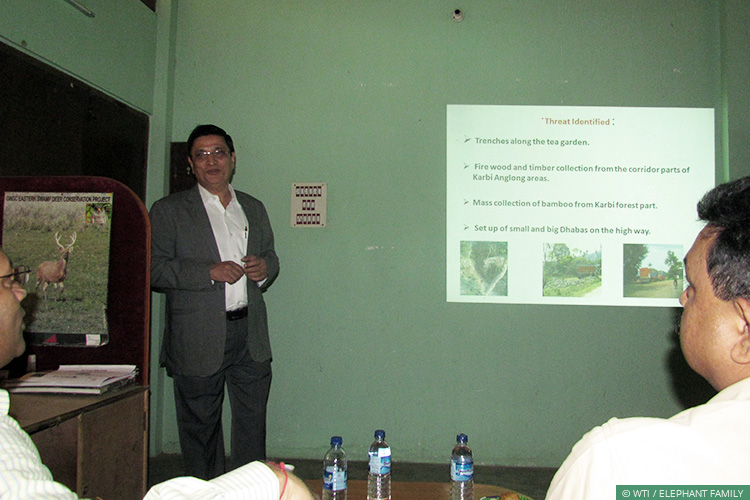 DBCSL CEO Mr Ataur Rahman makes a presentation during the Annual Review-cum-Planning Meeting
DBCSL CEO Mr Ataur Rahman makes a presentation during the Annual Review-cum-Planning Meeting
Kaziranga National Park, Assam, March 19, 2017: Wildlife Trust of India (WTI) and Elephant Family, with support from the Assam Forest Department, have developed a cadre of local individuals called the Green Corridor Champions (GCC) to help secure four crucial elephant corridors – Amguri, Kanchanjuri, Deosur and Panbari – in the Kaziranga-Karbi Anglong landscape. GCC teams have been put together in partnership with two regional organisations, BHUMI and the Duarbagori Cooperative Society Limited (DBCSL). In coordination with WTI and Elephant Family, they have been working to build a social momentum for the protection of these corridors among the communities that reside in and around them.
An Annual Planning-cum-Review Meeting of the GCC teams was organised at the IFAW-WTI Centre for Wildlife Rehabilitation and Conservation in Panbari on March 17. Dr Satyendra Singh (Chief Conservator of Forests and Director, Kaziranga National Park), Mr P Deka (Deputy Conservator of Forests, Kaziranga National Park) and Mr RB Saikia (Divisional Forest Officer, Eastern Assam Wildlife Division) represented the Assam Forest Department at the meeting. Mr Ataur Rahman, CEO, DBSCL and Mr Uttam Saikia, President, BHUMI were also in attendance with their respective GCC team members, as were members of the WTI project team.
The preparation of a roadmap for the securement and protection of the four corridors was topmost on the agenda; an emphasis was placed on getting all stakeholders to work together to identify and address activities that were adversely affecting habitat connectivity and elephant movement in and around corridor areas.
Ms Upasana Ganguly, Programme Officer with WTI’s Wild Lands division began proceedings with a detailed explanation of the concept underlying the Green Corridor Champions Network, and the plan to form and empower 50 GCC teams across all 101 identified elephant corridors in India. The two GCC teams then detailed their ongoing activities and the associated challenges and learnings till date; they also outlined the current and potential threats to elephant corridors in the Kaziranga-Karbi Anglong landscape and provided suggestions to tackle the same.
The Green Corridor Champions would work in partnership with WTI to sensitise local communities about the importance of elephant corridors and help in monitoring and securing them.
A discussion with the Assam Forest Department officials followed, wherein recommendations were made on securing and protecting the four targeted corridors. All the parties agreed that public support and involvement was of the utmost importance for the long-term protection of these corridors. Dr Satyendra Singh and Mr P Deka put forward the suggestion that WTI, the GCC teams and the Assam Forest Department work more closely with the concerned administrative divisions to ensure that developmental activities in and around the corridors would not affect animal movement. Also expressing his support for the Green Corridor Champions, Dr Singh said: “The GCC concept can go a long way in ensuring the proper monitoring and protection of elephant corridors. My best wishes and support are with them. Public involvement is key for this kind of work.”
The meeting concluded with Mr Dilip Deori, Project Lead, and Dr Rathin Barman, Senior Advisor – WTI thanking the Forest Department officials and other participants.
WTI plans to tie up with local organisations like DBCSL and BHUMI and form GCCs all across India, thereby institutionalising the involvement of community-based organisations in protecting and securing elephant corridors. The GCCs would work in partnership with WTI to sensitise local communities about the importance of corridors and, with the judicious and appropriate use of social, economic and technical interventions, and the vital support of local governments, help in monitoring and securing these corridors.